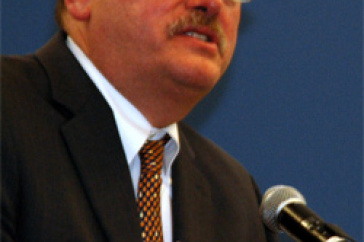UNH Launches Milestone Integrated Applied Mathematics Program

UNH College of Engineering and Physical Sciences Alumni Society 2010 Distinguished Alum Robert Phillips, of Hampton Falls says, "At UNH I was taught the fundamental joy of learning as well as how to apply that learning to solve problems." Credit: Carolyn Kirkpatrick
DURHAM, N.H. - After more than three years of preparation, the University of New Hampshire is launching its ambitious new Integrated Applied Mathematics (IAM) program this fall. It is hoped that this initiative will bridge the gap between the abstract and the applied in mathematics scholarship.
Housed within UNH's College of Engineering and Physical Sciences (CEPS), the graduate-level IAM program will be among a few select programs nationwide combining mathematical analysis and high-performance scientific computing to address real-world challenges. Among the program's features is a state-of-the-art supercomputing system made possible through an alliance between UNH and IBM, with additional funding from the National Science Foundation. The IAM program's emphasis on professional software development practices will prepare students for careers in academia, government research, or industry.
"Many mathematics programs in U.S. colleges focus on abstraction. However, the health of the U.S. economy will be determined by efforts like IAM to apply mathematics research to science and technology," says associate professor of mechanical engineering Greg Chini, who also serves as IAM co-director and a UNH Center for Fluid Physics faculty member.
IAM's concentration upon the interplay among mathematics (including mathematical model formulation and algorithm development), high-fidelity computing, and science and technology distinguishes it from similar programs, according to professor of mathematics Kevin Short who, with Chini, is IAM's co-director. After receiving core training in mathematical analysis and numerical methods, students will choose one of three specialization areas: fluid dynamics, nonlinear dynamics, or plasma physics. IAM students' dissertation research will allow them to collaborate with experts in UNH's Center for Fluid Physics, the Space Plasma Theory Group, the Center for Integrated Computation and Analysis of Reconnection and Turbulence (CICART), and the Center for Dynamics Research, which involves faculty in the departments of mechanical and chemical engineering, Earth sciences, physics, and mathematics and statistics.
IAM students choosing the fluid dynamics specialty, for example, will work with the Center for Fluid Physics to tackle the problem of turbulence. "Thanks to Newton, mathematics tells us the general behavior of fluids and gases. But knowing the rules doesn't imply that we can readily predict outcomes when these substances undergo stress or change," explains Chini. "Through IAM, we will advance toward better understanding of and, in engineering applications, ability to control turbulence within our world."
In this way, IAM scholars aim to develop better computational models of air-sea transfers of heat and carbon dioxide, which directly impacts climate; improved predictions of crude oil movements by upper ocean currents as in the wake of offshore drilling accidents; more accurate estimates of the location and intensity of clear air turbulence which can lead to wind shear (a major aviation hazard); and better understanding of capillary blood flow and airway stability to enhance clinical treatments of cardiovascular and pulmonary diseases.
Within the plasma physics specialty, IAM participants will examine the interplay between magnetic fields in the universe and plasmas, the fourth state of matter. "With IAM's focus on advanced computing and mathematical analysis, we hope to extract further meaning and understanding of this process," explains Amitava Bhattacharjee, a founding member of the IAM program, who is the Peter Paul Professor of Physics and director of CICART.
CICART studies the plasma phenomena which underlie the dynamics of the sun's magnetic fields, as well as plasmas in the laboratory which try duplicating fusion reactions at the sun's core. "The abundance of hydrogen and deuterium in seawater means that, once developed, fusion could provide an almost inexhaustible energy source," says Bhattacharjee. By developing sophisticated mathematical models and computer simulation codes, IAM students could help uncover the secrets of the sun's eruptive dynamics, the Earth's magnetosphere storms, and instabilities in fusion devices.
Chaotic dynamics will be part of IAM's nonlinear dynamics specialty. "New England weather with its frequent changes is characterized by chaotic dynamics," says Short. Similarly, system breakdowns - in everything from rail services to municipal lighting networks - are another form of chaotic dynamics. IAM's nonlinear dynamics specialists will seek to forecast and control chaos within such systems.
IAM's launching completes a lengthy evaluation process ensuring program integrity. "The program's external review was very detailed, with input from throughout the university system," says Short. In addition, Bhattacharjee credits much of IAM's establishment as a CEPS-wide program to Joseph Klewicki, outgoing CEPS dean. "His direct intervention and interest helped make this program possible," he says.
Program reaction is very favorable, especially among students. "Our first class includes undergraduate mathematics, science and engineering majors eager to engage in a quality graduate program emphasizing mathematical modeling. Recruits have come from major universities in the U.S. and abroad," says Short.
Looking ahead, IAM supporters have high hopes for the program. "In the long run, we want to produce professionals who embrace the academic value of mathematical analysis while appreciating its potential for scientific and technological applications," says Short.
The University of New Hampshire, founded in 1866, is a world-class public research university with the feel of a New England liberal arts college. A land, sea, and space-grant university, UNH is the state's flagship public institution, enrolling 12,200 undergraduate and 2,200 graduate students.
-30-
Reporters and editors: Greg Chini, associate professor in the Department of Mechanical Engineering, can be reached at 603-862-2633 and greg.chini@unh.edu. Kevin Short, professor in the Department of Mathematics and Statistics, can be reached at 603-862-2623 and mailto:kevin.short@unh.edu"
-
Media Contact
Debra Williams | UNH College of Engineering and Physical Sciences | debra.williams@unh.edu | 603-862-3102
Latest News
-
July 2, 2024
-
June 18, 2024
-
June 18, 2024
-
May 17, 2024
-
May 14, 2024

















































